The cornerstone of any PR strategy is having your own personal database of journalists’ contact details. If you want to win earned media in newspapers, trade journals, or online publications, you need to send your pitch to the right journalists. But the question of how to find journalists’ contact details is one that can stump a lot of people.
Thankfully, there are plenty of effective free tools to find journalists’ contact details in 2020. To help you on your way, here’s a walkthrough of my favourite outreach tools that will help you score the press email addresses you have been longing for.
Target journalists, not publications
Before you go on a quest to find reporters’ contact details, you need to identify the most relevant journalists in your industry.
Say for example you want to send a press release to TechCrunch. The mistake many people make is to send it to the generic email address. These email addresses are the black holes of publications, usually manned by interns. You should instead always aim to contact a journalist directly. These guys are the decision makers, after all.
This means you need to do a two step process:
- Identify which journalists are the most relevant to your business
- Find the contact details of these journalists
How to find the most relevant journalists
Getting an article written about your company is a means to an end, not an end in itself. The ultimate objective is to get your message in front of your target audience: the readers of the publications.
So the first thing to answer is — who is your target audience?
This will depend on what your PR goals are. Are you trying to secure funding? Increase awareness of your brand? Educate consumers about your product?
Our guide to PR provides insights how to determine your goals, and our PR for Growth Playbook gives you step by step instructions how to achieve them.
At a high level, these are the steps to work through:
- What are you trying to achieve with your PR Strategy?
- Who do you need to reach to achieve those goals?
- What publications do they read?
- Who are the journalists and reporters writing for these publications that are the most relevant to your brand and your message?
Start a media database by using your own knowledge
Make a list of all the publications you already know that your buyer personas would typically read. Think about both industry specific and mass market publications. However, keep in mind that although top tier publications give you more visibility and reach, niche journalism is often an easier way to get your foot in the door.
Snoop on your competitors with Google News and Moz
Next, make a list of your main competitors and start identifying the publications they’re winning earned media in. Do a Google News search of each of your competitors, and note the publications, reporters and topics of any outlets that are relevant to your buyer personas.
Delve a bit deeper into your competitor’s earned media wins by signing up to the free version of Moz or Linkio. If you’re using Moz, click on Free SEO Tools, then Link Explorer. Enter the domain of each of your competitors’ websites, then do as follows.
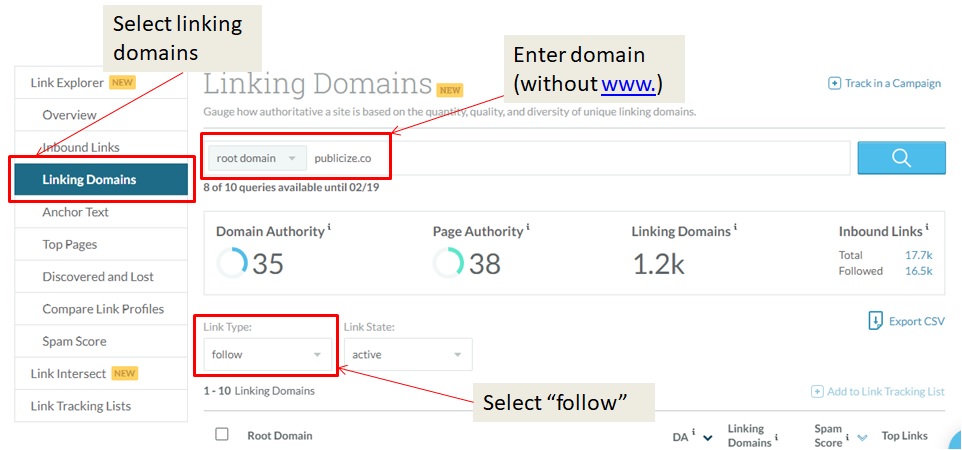
Now explore all of their earned media wins by doing the following:
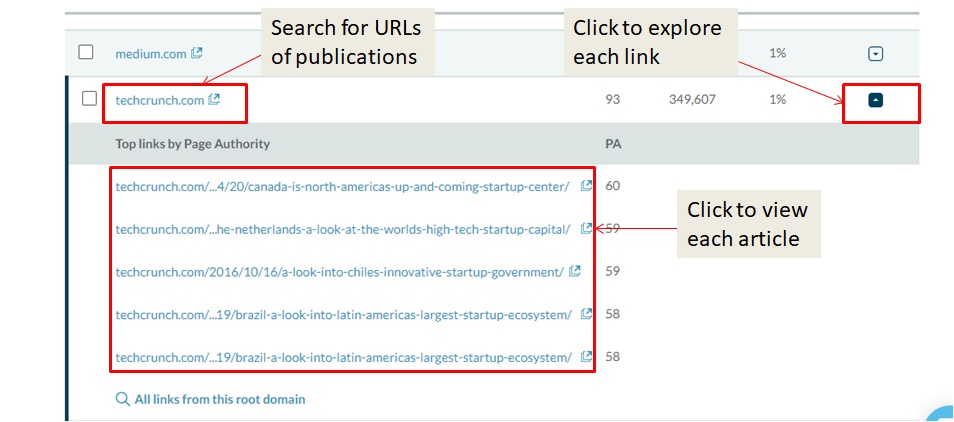
Add all the relevant reporters that you find and the publications they work for. Heads up, you only get a limited amount of searches and results with the free version. You can sign up to a 30 day free trial of their premium service, but just don’t forget to cancel it!
Expand the search for publications with Similarweb
Now it’s time to expand the net. A great tool we use for this is Similarweb. Simply enter each of the publications you’ve listed from the above exercises and follow the below steps. In this example we’ve enter the URL of TechCrunch.
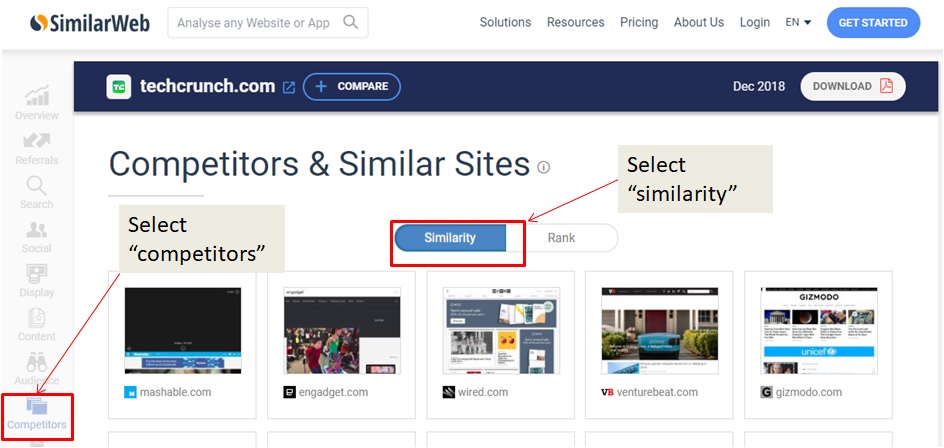
Review all of the publications’ websites listed under the ‘similarity’ tab and add all those that are relevant to your audience in your database.
Now you’ll have an extensive list of media outlets. But remember, it’s not the publications you want to contact, but rather the journalists and reporters who write for them.
Determine relevant keywords and search which journalists are covering them
To find the right journalists at each of the publications on your list, search every media outlet for relevant keywords to your business or industry. If a site doesn’t have a search box, just use the following syntax in Google to search the site; site:publicize.co “startups” (obviously first replacing the URL and keyword to the ones you’re searching for!)
Now add the relevant journalists’ names under each publication that you’ve listed, along with the keyword topics they write about. If you already find journalist’s contact details while doing this, add it to your database.
This exercise provides a solid foundation of relevant publications and journalists. To expand the net even further, do a media scan of your keywords in Google News. Add any relevant information that you haven’t already come across to your journalist database.
Expand your press database with Muck Rack and Anewstip
Lastly, rinse and repeat the same process using Anewstip and Muck Rack. These are great tools for finding journalists grouped by keywords. Anewstip shown below is free, but Muck Rack requires a subscription.
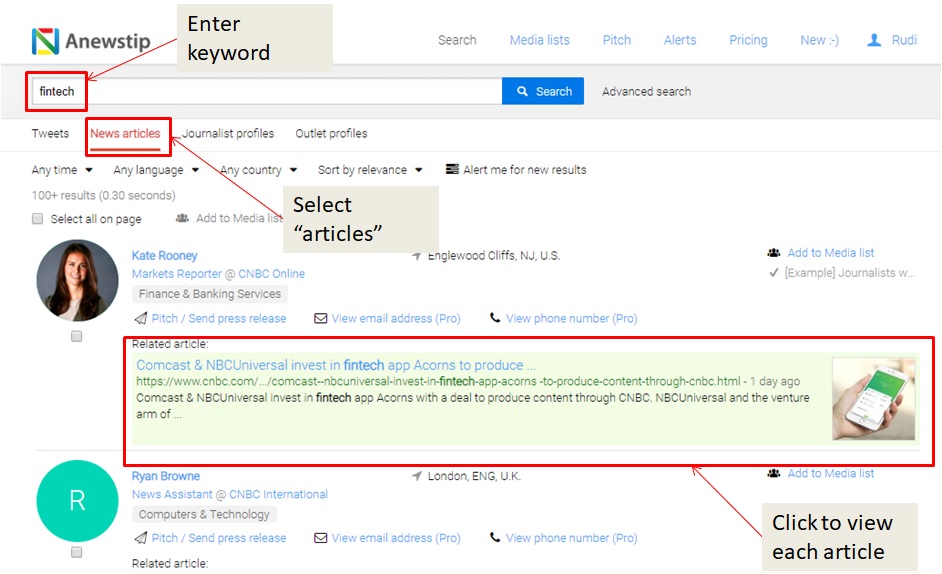
How to find journalists contact details
Once you’ve acquired a comprehensive list of journalist names, it’s time to find their contact details.
Always try and find their email address, rather than reaching out via a social channel. LinkedIn and Twitter are great platforms to start creating relationships with journalists, but not the right channel to send your pitch.
Search press emails addresses with email finder tools
For the remaining journalists, you can either do it the slow way for free, or the quick way for a fee. The slow but free way is to use Hunter. This free tool tells you the email address format for any domain that you search for. You then just backmatch this against each journalist name you’ve listed at each publication. Just follow the below steps to do this.
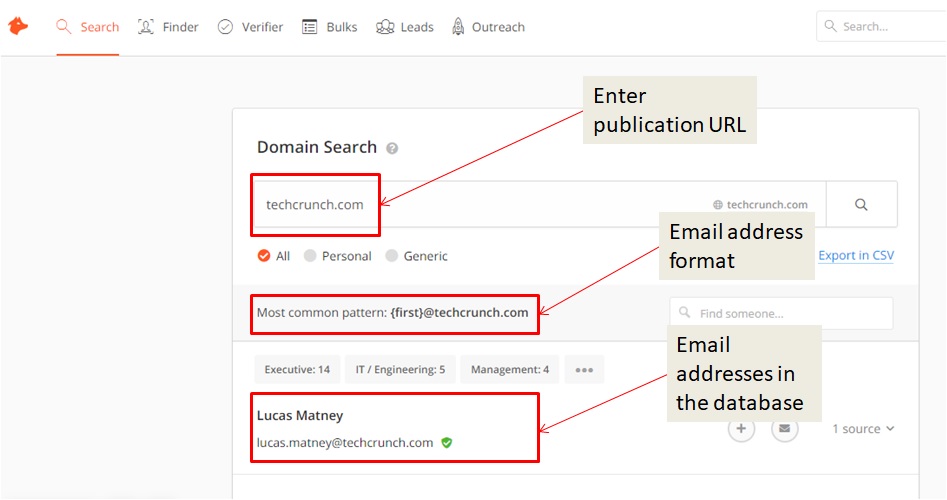
Other similar outreach tools you can use for free are Voilanorbert and Who.is.
The quicker way is to sign up for a tool like Cision, which hosts one of the largest journalists’ databases. They don’t publish their rate card, but for small businesses prices reportedly start at $20 a month, although that may require some good haggling.
Wrapping Up
So this is how to find journalists’ contact details for free. Just follow our process: identify the publications most relevant to your target audience, and search for the journalists who write about topics relevant to your business working at each of these publications. Then do a bit of sleuthing to find their contact details.
Finally, once you have your custom-made list of press email addresses ready to go, read our tips on how to build relationships with journalists to get your pitches picked up.








